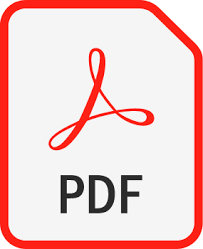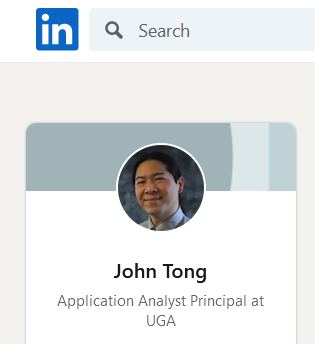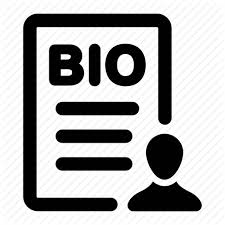
Welcome!
This is John Tong’s ePortfolio as a Master’s Candidate in the Learning Design and Technology program at the Mary Frances Early College of Education, UGA. Below you will find professional credentials, personal statements, program of study and sample artifacts on the various programmatic themes.
Site Overview Video
Personal
Overview Statement
Program of Study
Course Work (Click to expand/contract)
| Semester | Course | Course Description | |
|---|---|---|---|
| (Two Semesters of Non Degree Classes) | |||
| Spring 2018 | CSCI 6360 | Data Science II | A |
| Summer 2018 | CSCI 6370 | Database Management | A |
| Start of LDT Coursework | |||
| Fall 2018 | EDIT 6100E | Intro Inst Tech | A |
| EDIT 6170E | Instructional Design | A | |
| Spring 2019 | EDIT 6190E | Design and Dev Tools | A |
| EDIT 7350E | eLearning Eval and Assessment | A | |
| Summer 2019 | EDIT 6400E | Teach Learn Technol | A |
| EDIT 6500E | Educ Vid Production | A | |
| Fall 2019 | EDIT 6900E | Research in IT | A |
| EDIT 7520E | Online Teaching and Learning | A | |
| Spring 2020 | EDIT 6200E | Lrn Envir Design I | A |
| MGMT 7220 | Project Mgt | A | |
| Summer 2020 | EDIT 6000 | Spec Prob in Instruct Tech | S |
| ( Learning Environments II ) | |||
| Fall 2020 | EDIT 6000 | Spec Prob in Instruct Tech | |
| ( Human Performance Improvement ) | |||
| EDIT 7170E | Advanced Instructional Design |
Programmatic Themes
Foundations (Click to expand/contract)
For my foundational theme artifacts, I have chosen my deliverables from the Research in Instructional Technology class, EDIT6900 taken with Dr. Hill and Dr.Woods. In that class I had chosen an area of interest unrelated to my ‘day job’, but that still had significant importance to my the daily practice of Archery, which was to address the ‘common wisdom’ that an inch of draw difference would result in some arbitrary number of pounds of difference in draw weight, which I have seen everything from 2-5 pounds over the years. I conducted a full literature review, interviewed World Games archers, and conducted experiments. This resulted in the academic paper below. Since my goal was to have this be meaningful research, I needed a format that my students could use, so I also spoke with some writers and created a magazine style article and a ‘pitch kit’ to get this information to people in a way they could use it. I feel these artifacts show a level of comfort in both the research process and academic writing side as well as in a way that makes it accessible to the public, despite it being a highly complex subject.
Analysis (Click to expand/contract)
For my Analysis artifacts, I chose what I feel is one of my capstone projects in the program, the final report for the Human Performance Improvement class, taken as EDIT6000 with Dr. Stefaniak.
For this assessment project I had conducted a thorough needs assessment, needs analysis, and organizational analysis on a highly ‘open’ question of what differentiated exemplar schools from reference schools that made them so effective in advisement interventions. As noted in my Overview statement, this project had many twists and turns, and in the end I needed to create two deliverables, one for the HPT aspects for the class, and one more focused on specifically what the client requested (included in the appendix). I am still in discussion with the client on expanding the culture section of the final document.
 HPT Final Report Draft | PechaKucha Presentation on Culture as a non-instructional intervention. Inspired by the HPT project. |
Design (Click to expand/contract)
For my Design artifacts I am presenting two different lessons that I worked on. The first was very early in my classes on formalizing the teaching of Whistle Commands to new, young archers. I saw a need when I first started volunteering with the Girl Scouts and the 4H youth that the first few lessons were very ad hoc. This was very inefficient and a perfect opportunity to start out using a teaching model, in this case the ID4T. This was created in EDIT6170 Instructional Design I, with Dr.Rieber.
My second deliverable here is a collaboration with a fellow LDT classmate Jessica Todd, a Spanish teacher, of which I am particularly proud.It was created as part of EDIT6400 Emerging Approaches in Teaching, Learning, and Technology with Dr.Knapp. It was started during a wave of anti-Hispanic sentiment in the US caused by a series of policies, statements, and actions by our Presidential administration. We collaborated extensively and co-wrote the lesson involving ‘real world’ interaction, I did the ‘field research’, finding stores, meeting owners, taking pictures and asking for permission and arranging for visits with students. My team-mate taught me a great deal about curriculum development from a practitioner perspective and we created a full lesson set based on our work that she was able to use in her classes.
Development (Click to expand/contract)
For my development examples, I am including some of the PSAs I created for the 4H, where I coach the youth team, as well as for the SCA. These were created as part of EDIT6500, Educational Video Production with Mr. Braxley. Both of them were situations where there were rules in place, but there were never formalized into educational material.
I am also including one of my larger volunteer projects I created as part of my EDIT7170 Advanced Instructional Design Class with Dr.Stefaniak. During COVID there has been a great need for the Youth and Family Achievement program of the SCA for digital content to help maintain involvement. I volunteered to create content starting with simple tasks like ‘Stringing a bow’ but also much larger topics such as understanding the parts of the arrow and how to build arrows. This demonstrates my comfort with creating full motion video productions as well as instruction and curriculum development.
Implementation (Click to expand/contract)
For Implementation, I am presenting this site, DataNinja.org as my artifact. Though design was begun with Dr. Knapp in EDIT7520, Online Teaching and Learning, I didn’t really get a chance to make a push on creation until this past summer in EDIT6000, taking the place of Learning Environments II with Dr. Stefaniak. It will be a platform that will allow me to consolidate and present a wide variety of educational material. From my experience as a graduate student, learning happens in many different ways, but in technical contexts this often happens in an ‘on demand’ and informal basis. I wanted to create resources for fellow practitioners of data analytics to get at the information they need in a way they want it.
My intent is to create a number lessons in different modes, blog entries, videos and articles, hosted on different platforms that practitioners use. They can then follow links back to this common platform to find blog articles, different videos, or reference papers/presentations. As an example, a student may look up SELECT statements on YouTube, find one of my videos, then find a link back to my platform to the blog article that provides exercises and more detail.
As mentioned in my other statements, this site is pretty bare bones right now, but the foundation is there, and I have learned an immense amount about hosting, market research, and site administration in even getting this much done. In one specific instance, I learned about Anti-spam plugins, which have been a life saver. Even though this site is not ‘live’, it has intercepted thousands of attempts to create content comment spam, it took me days to understand the comment system, put it in effect, and clean up the spam from just my first few days of my first post this Summer. This overall has taken a lot more time than a COVID workload professional with Graduate coursework could work on, but I am excited to continue this work as a passion project going forward and helping the next generation of students be people I would hire.
Evaluation (Click to expand/contract)
For my Evaluation artifact. I am presenting the final report and presentation from the EDIT7350 Evaluating eLearning class, taken with Dr.Stefaniak. I obviously used various forms of evaluation in many of my projects, but this was one of the largest projects I had evaluated, and it was also of interest that it was with a team. I greatly enjoyed my interactions with my team mates and learned a great deal in this project that I don’t think I fully appreciated, or internalized until much later in my academic career. Approaching evaluation with a real client was fantastic, and I also started volunteering with them for a while after this project. As for the portions where I contributed, I was an active contributor to all the sections in the edit phase, but was primarily responsible for the analysis, recommendations, and the video presentation at the end of the course linked below.
F4 Final Video Presentation PechaKucha format created by John Tong | F4 Final Report |


